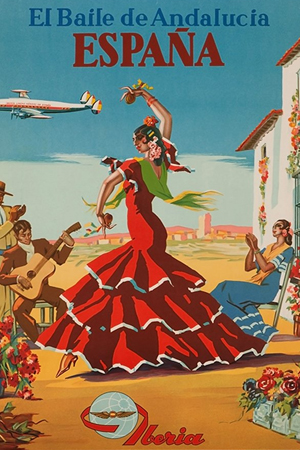SINGAPORE, 19 June 2024: The Primitive Way is very similar to the original route of the Camino de Santiago, which began in the 9th century with the discovery of the tomb of Saint James the Apostle and the devotion of King Alfonso II, who made a pilgrimage.
It mainly follows tracks through natural settings. The route goes from Oviedo (Asturias) to the Cathedral of Santiago de Compostela, crossing the forests and valleys of Asturias to join up with the French Way in Palas de Rei (Galicia).
The route of the Primitive Way is possibly the most demanding, especially if cycling, where a mountain bike is recommended.
ASTURIAS
Approximate distance: About 170 km.
Recommended stages: 7 or 8.
The landscape you’ll be walking through is mainly rural, with small farming villages and not much industry. It takes you through the lushest nature of Asturias and maybe the least urban part of the Camino de Santiago.
If you’re sightseeing, Oviedo is worth visiting, with its cathedral and World Heritage pre-Romanesque churches. In Valduno, you can see the Roman baths of Santa Eulalia. The pretty town of Salas is home to the Collegiate Church of Santa María la Mayor, and in Cornellana, you will find an important example of Romanesque and Baroque art in the Monastery of San Salvador.
The terrain in the final part of the route in Asturias is more rugged, and there are beautiful spots like the Grandas de Salime reservoir and the climb to Puerto de Acebo.
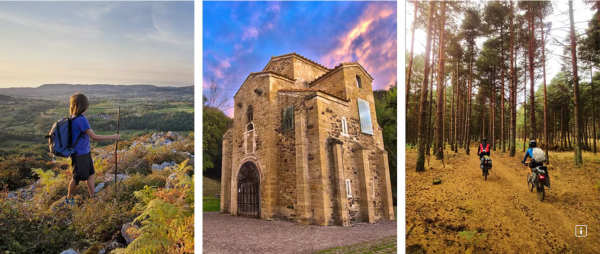
You’ll like:
Having a meal in the historic town centre of Oviedo, discovering the tradition of Asturian ciders and the enormous food portions.
Walking in the footsteps of the first pilgrims. Many people say that the Primitive Way is the closest to the origins of the pilgrimage route, as it is mostly in natural settings, far from the cities, and less crowded. There is a variant from Tineo to Boures that conserves part of the original route. Remember that you do need to be in good physical shape to follow it.
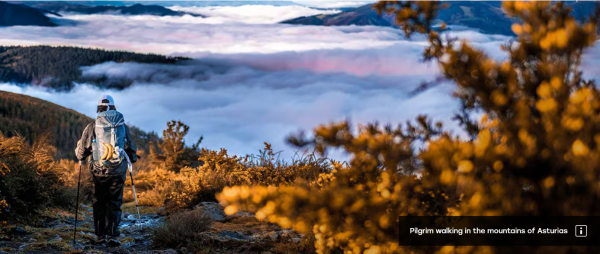
World Heritage sites to visit: Most visits are in the city of Oviedo: the Cámara Santa in the cathedral, the Foncalada (a fountain in front of the cathedral), the churches of Santa María del Naranco and San Miguel de Lillo (both on Monte Naranco) and the San Julián de Prados. They are all part of the World Heritage site, including the Monuments of Oviedo and the Kingdom of the Asturias.
Main stops on the Primitive Way of the Camino in Asturias: Oviedo – Grado -Tineo – Pola de Allande – Grandas de Salime – Puerto del Acebo. More information: The Primitive Way of Saint James in Asturias
Galicia
Distance: 150 km.
Recommended stages: 6 or 7.
Alto da Fontaneira and its amazing views welcome you to Galicia on the Primitive Way. The terrain gradually becomes easier to walk on, and you’ll often find cattle grazing nearby. In many places, the route follows stretches of Roman road.
Lugo is the largest city before you reach Santiago de Compostela, and it still has many traces of its Roman past, notably the city walls. Much of the old town centre is pedestrianised, making it pleasant to walk through. The Camino also goes through small villages like Castroverde (with a pretty path through chestnut trees nearby), Palas de Rei, Melide and Arzúa.
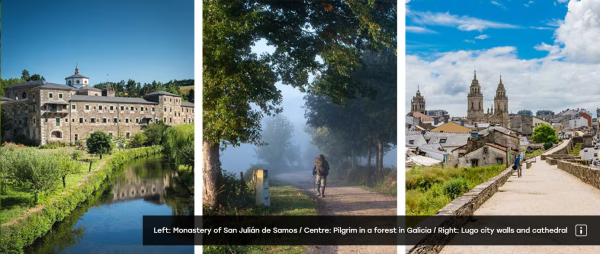
You’ll like:
The contrast between the rural atmosphere of most of the path and the two cities on the route. Santiago de Compostela and Lugo are both busy and lively, and they are great places for enjoying the cuisine of Galicia, noted for its seafood and classic dishes like pulpo a feira (octopus).
The constant feeling of contact with nature, the views of valleys, and spotting little villages in the distance, nestled among the greenery. You can also explore the popular culture, which in Galicia often involves magical legends and witches.
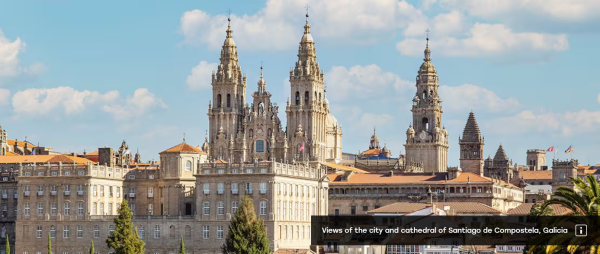
World Heritage sites to visit: Lugo city walls, the only Roman city walls in the world with their perimeter still intact. Approximately an hour by car from Lugo or Santiago de Compostela, you will have the opportunity to visit another monument declared a World Heritage Site: the Tower of Hercules, a Roman lighthouse that is still in operation in A Coruña.
Main stops on the Primitive Way of the Camino in Galicia: Castroverde – Lugo – Palas de Rei – Melide – Arzúa – Santiago de Compostela.
For full details on the Primitive Way, head to the website.
For more on Spain’s travel experiences, visit https://www.spain.info/en/

(Source: Spain Tourism Board – Southeast Asia, Australia & New Zealand).


